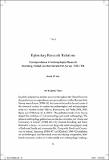| dc.description.abstract | In public and personal archives scattered throughout the United States lie the professional correspondences and personal letters of the Harvard-Irish Survey research team (1930 36) that came to Ireland in the early years of the twentieth century to conduct an archaeological and anthropological study of a modern society (Byrne, Edmondson, and Varley 2001; Byrne and O Mahony 2012 and 2013). The published works of the Survey shaped the evolution of Irish archaeology and social anthropology. The physical anthropology publications receive less attention, but Family and Community in Ireland ([1940] 2001) by Conrad Arensberg and Solon Kimball is a classic a controversial, frequently cited ethnographic study of Irish rural family and community life. Along with Family and Community in Ireland, Arensberg (1910 97) and Kimball (1909 82) published on methodological and theoretical issues introducing comparative, field-based community studies as a substantially new anthropology, making a significant contribution to the interdisciplinary study of modern European and North American societies (Comitas 1999, 811). In Ireland, Arensberg and Kimball devised a new paradigm for studying culture and community, characterized as the intensive observation of the minutiae of social life, and it had far-reaching effects.
Focusing on the social anthropology strand of the Harvard-Irish Survey, this chapter examines unpublished professional and private letters of the first visit of an American team of anthropologists and archaeologists to Europe. How letters are deployed in the Survey, who writes to whom, what is relayed, requested, or refused: these themes inform the dynamics of research relations and the deployment of a novel research strategy providing a focus on informants voices, perspectives, and practices in service of the Survey. A narrative approach to the analysis of letters is introduced.
Two slim brown-paper folders, frayed with age, lie on my desk. Bundles of correspondence on brittle yellowing sheets of paper of various sizes, neatly labeled and categorized, are inside. Some letters are typewritten on headed note paper, letter characters paler here, darker there, reflecting the uneven spread of ink on typewriter ribbon or the varying force of fingers striking typewriter keys. The day, month, and year are duly noted, the address of the recipient clearly placed on the top left-hand corner of the page, followed by a singular Dear Sir. The content is closely crowded onto the page, utilizing all available space, signed off with the flourish of a handwritten signature, bold in blue ink. Handwritten letters in pencil on pages torn from school copybooks have their places in the archive too, carefully numbered page by page.
Some bundles of letters are substantial, indicating regular exchanges of correspondence, perhaps maintaining old or building new relationships. Others are one-off invitations to attend events or a kind acknowledgment of books received from secretaries of learned societies and state bodies. The personality and character of the writer is suggested by the quality and shape of the paper, the color of the ink, the size and form of the handwriting, the forceful expression of ideas, the colloquial use of language, the formality of tone, the regretful refusal, the polite inquiry, the gossip conveyed, the rude interjection, the news of the day. The immediacy of the voices and the urgency of the content are as compelling as the materiality of the physical presence of the letters, working to dissolve the illusion of time between now and then. Preserved for more than eighty years, these aged, fragile letters were intended by Arensberg and Kimball to be kept and read at some future time, perhaps by themselves or by an unknown person. I have acquired Survey letters, diaries, and documents from public and private archives. Transcribing and reading these letters aloud provokes the imagination and pushes the mind into a different space, time, era. What can they, these writers of letters, tell us, the unintended recipients, the not-addressed audience? How can these letters inform us about the experiences of the unseasoned young American anthropologists, Arensberg and Kimball, as they set about their research tasks in the towns and countryside of 1930s Ireland? What else can we learn from letters in the archive? | en_IE |


